The Deliverance of St. Peter– between reality and a vision
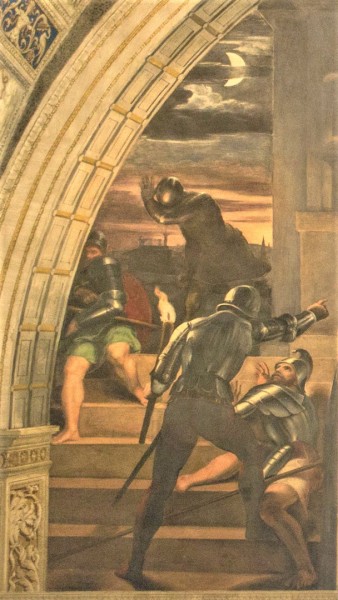
The Deliverance of St. Peter, fragment, Raphael, and his workshop, Stanza di Eliodoro, Apostolic Palace
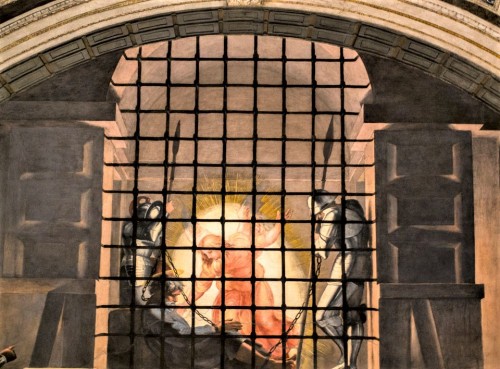
The Deliverance of St. Peter, Raphael, and his workshop, fragment, Stanza di Eliodoro, Apostolic Palace
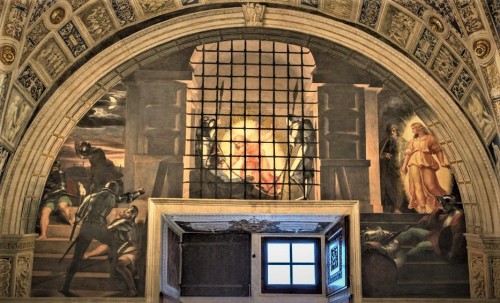
The Deliverance of St. Peter, Raphael, and his workshop, 1514, Stanza di Eliodoro, Apostolic Palace
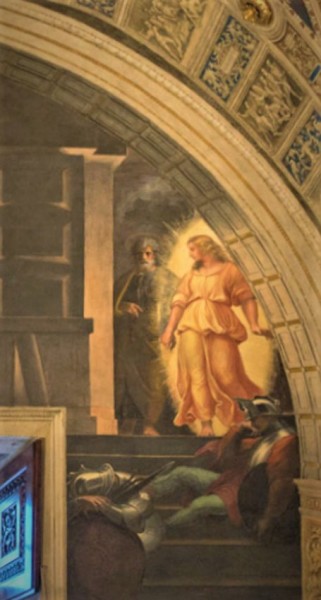
The Deliverance of St. Peter, Raphael, and his workshop, fragment, Stanza di Eliodoro, Apostolic Palace
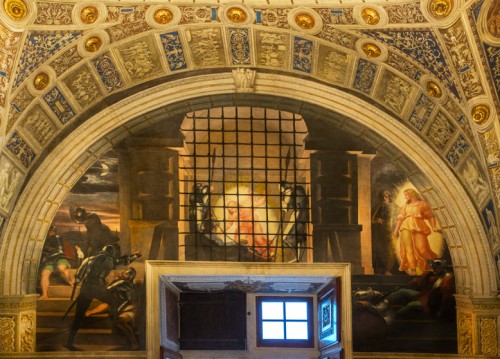
The Deliverance of St. Peter, Raphael, and his workshop, Stanza di Eliodoro, Apostolic Palace
Here in front of our very eyes, a mysterious scene takes place, written down in the Gospel of St. Luke. We are in Jerusalem. Christ had been crucified a few years prior. The ruler of Judea, King Herod Agrippa I, had already for some time been wanting to appeal to the Jews and persecutes a sect of Christians (Jews believing in Christ). He orders one of Jesus’s companions – James to be executed and has Peter imprisoned. Why him? It seemed that Peter was the leader of the new religious movement. Locked in prison and guarded by four regiments (four soldiers in each) after the Passover (41 A.D.?) he was to be judged. Here let us let the Gospel speak: “And behold, an angel of the Lord stood next to him, and a light shone in the cell. He struck Peter on the side and woke him, saying, “Get up quickly.” And the chains fell off his hands. And the angel said to him, “Dress yourself and put on your sandals.” And he did so. And he said to him, “Wrap your cloak around you and follow me.” And he went out and followed him. He did not know that what was being done by the angel was real, but thought he was seeing a vision” (Acts 12, 5-9).
Here in front of our very eyes, a mysterious scene takes place, written down in the Gospel of St. Luke. We are in Jerusalem. Christ had been crucified a few years prior. The ruler of Judea, King Herod Agrippa I, had already for some time been wanting to appeal to the Jews and persecutes a sect of Christians (Jews believing in Christ). He orders one of Jesus’s companions – James to be executed and has Peter imprisoned. Why him? It seemed that Peter was the leader of the new religious movement. Locked in prison and guarded by four regiments (four soldiers in each) after the Passover (41 A.D.?) he was to be judged. Here let us let the Gospel speak: “And behold, an angel of the Lord stood next to him, and a light shone in the cell. He struck Peter on the side and woke him, saying, “Get up quickly.” And the chains fell off his hands. And the angel said to him, “Dress yourself and put on your sandals.” And he did so. And he said to him, “Wrap your cloak around you and follow me.” And he went out and followed him. He did not know that what was being done by the angel was real, but thought he was seeing a vision” (Acts 12, 5-9).
This story was illustrated on one of the walls of the Stanza di Eliodoro, meaning a room (stanza), whose name was taken from a painting found within, one of the four scenes created by Raphael, at the wish of Pope Julius II. All of them spoke of the victorious role of Christianity and its representatives over the ages. Their common denominator was the desire to show the miracle of divine intervention, whose source is constant prayer. As the author of the Gospel according to St. Luke suggests: “So Peter was kept in prison, but earnest prayer for him was made to God by the church". The Church, which we know, at that time, did not exist as an institution, here meant simply a prayer of the faithful – followers of Christ. Then, God himself intervenes in a miraculous way. This emphasis on the active participation of the commune in the work of the liberation of Peter is meant to show the significance of the apostle as the successor of Christ and at the same time the significance of the pope himself – the continuator of his work. This fits perfectly with the words of Julius II himself: "The Lord is my helper. I will not fear what any man can do to me". Certainly, the pope was sure of the prayer support of his Church, while recalling the scene of the deliverance of Peter on the wall of his private apartment had both a political and a propaganda dimension – it legitimized his authority as Peter's successor and directed everybody's attention to the divine aid, which he could be sure of. He could look at himself as a guardian of exceptional relics. Let us recall: Before Julius II became pope, he was the titular cardinal of the Church of San Pietro in Vincoli, where the chains of Peter were kept, those that were miraculously found in Jerusalem and transported to Rome. However, let us return to the fresco itself, the Deliverance of St. Peter, probably one of the most beautiful if not the most beautiful nocturne of the Italian Renaissance. Here we have three scenes in chronological order. The first and the main one occupies the central spot above the window. The sleeping chained Peter is awakened by an angel emanating with light. An armed guard fell asleep and did not hear his entrance, and neither did he hear the apostle rising to leave, who in the next scene (on the right side, looking straight) is descending with the angel holding him by the hand, moving between the sleeping soldiers. On the left we will notice their general, who is shouting at his subordinates, probably berating them for the fact that they were sleeping while Peter fled. In a distance, we can see the moon, hidden behind clouds but also the Golgotha with crosses reminding us of the death of Christ.
It was no accident that this scene was painted on the window wall. The light coming in through the window makes the episode presented on the wall darker still. This natural light blinding the viewer gave this representation a supernatural dimension. Because it is this light that is in fact the protagonist of this scene suspended between reality and the "vision" mentioned by Peter. The moon shown on the left and the glow of the day constitute two sources of brightness, but not the only ones. We also have the “miraculous” glow emanating from the angel, the light of the torch illuminating the interior held by the leader of the guards, and finally light impastos reflecting on the guardsmen’s armor.
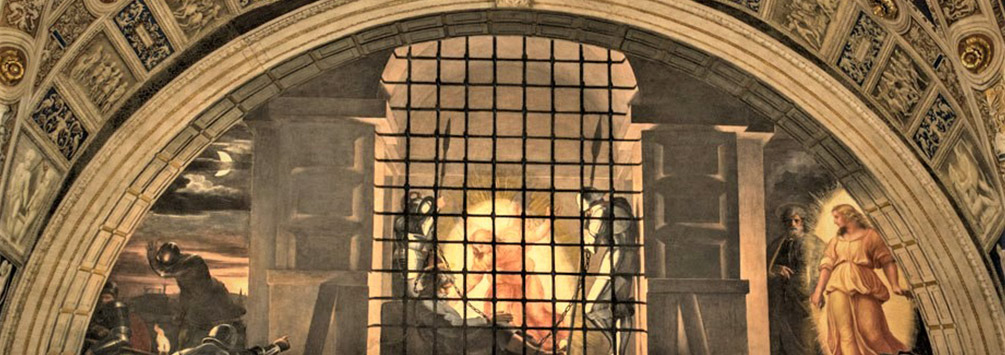
Of equal interest seems to be, the unknown until that time in art, method of showing a room (prison), through a grate and in addition against the light. Raphael’s concept was novel and it required quite a bit of technical virtuosity. Presenting supernatural light, nuancing various luministic effects, balancing between deep shade and half-shade, all of these were a challenge to the technique of the fresco. Created on fresh plaster it does not allow for corrections. After the plaster dries the scale of shade and light can neither be decreased nor intensified. One needs a lot of imagination and skill to make all these elements fit together in one harmonious whole.
And while in the previous apartment (Stanza della Segnatura) Raphael fully controlled the fresco making process, in the Stanza di Eliodoro it was different. The enormous amount of work which he had to deal with, caused him to cede some of his tasks onto his collaborators and students – artists of exceptional ability, who from that moment on would be the main creators of the visions conceived in his mind.
The Deliverance of St. Peter, Raphael, and his workshop, 1514, Stanza di Eliodoro, Apostolic Palace
If you liked this article, you can help us continue to work by supporting the roma-nonpertutti portal concrete — by sharing newsletters and donating even small amounts. They will help us in our further work.
You can make one-time deposits to your account:
Barbara Kokoska
BIGBPLPW 62 1160 2202 0000 0002 3744 2108
or support on a regular basis with Patonite.pl (lower left corner)
Know that we appreciate it very much and thank You !












